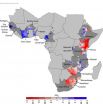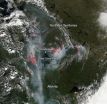(Press-News.org) Today's food production relies heavily on irrigation, but across sub-Saharan Africa only 4 percent of cultivated land is irrigated, compared with a global average of 18 percent. Small-scale farming is the main livelihood for many people in the region, who depend on rainfall to water their crops.
To understand how climate change may affect the availability of water for agriculture, researchers at Princeton University analyzed trends in the water cycle in maize-growing areas of 21 African countries between 1979 and 2010. The team examined both levels of rainfall and the evaporative demand of the atmosphere — the combined effects of evaporation and transpiration, which is the movement of water through plants.
Overall, they found increases in water availability during the maize-growing season, although the trends varied by region. The greater availability of water generally resulted from a mixture of increased rainfall and decreased evaporative demand.
However, some regions of East Africa experienced declines in water availability, the study found. "Some places, like parts of Tanzania, got a double whammy that looks like a declining trend in rainfall as well as an increasing evaporative demand during the more sensitive middle part of the growing season," said Lyndon Estes, the study's lead author and an associate research scholar in the Program in Science, Technology and Environmental Policy at the Woodrow Wilson School of Public and International Affairs. The analysis was published in the July issue of the journal Environmental Research Letters.
A key goal of the study was to incorporate reliable data on factors that influence evaporative demand. These include temperature, wind speed, humidity and net radiation — defined as the amount of energy from the sun that is absorbed by the land, minus the amount reflected back into the atmosphere by the Earth's surface. Measurements of three of these parameters came from the Princeton University Global Meteorological Forcing Dataset (PGF) previously developed by two of the study's authors, Research Scholar Justin Sheffield and Eric F. Wood, the Susan Dod Brown Professor of Civil and Environmental Engineering and the study's senior author.
The PGF merges a variety of weather and satellite data, and covers all land areas at a resolution of three hours and one degree of latitude or longitude (one degree of latitude is about 70 miles). Nathaniel Chaney, a graduate student who works with Sheffield, downscaled the data to a resolution of about 15 miles. He incorporated observations from African weather stations to improve the accuracy of the data. To do this, he used statistical techniques based on the principle that areas close to one another are likely to have similar weather.
The team also had to correct the data for errors due to changes in instruments or satellites, which can create what appear to be sudden jumps in temperature or wind speed. "When you're dealing with gridded global weather data, they come with many warts," Estes said. "So we try to remove as many of those warts as possible," he said, to gain a faithful picture of weather changes at each location.
Most areas saw a decrease in evaporative demand, leading to higher water availability. The researchers analyzed the contributions of different factors to this decrease, and found that a downward trend in net radiation was largely responsible for the change. This was a surprising result, according to Estes, who said he expected to see decreases in evaporative demand, but thought lower wind speeds would have a greater impact than drops in net radiation. In a 2012 study published in the journal Nature, Sheffield and Wood showed that diminished wind speeds have helped to offset the effects of rising temperatures that would otherwise lead to an increase in droughts. Another study found that decreasing wind speeds contributed to declining evaporative demand in South Africa. The current study only examined water availability during the maize growing season, which could account for this discrepancy, Estes said.
The trends revealed by this research could have implications for agricultural policies and practices, including irrigation planning, timing of planting and choice of crop varietals. For example, in Burkina Faso in West Africa, a comparison of different parts of the growing season showed a decrease in water availability early in the season, but an increase at later time points. This might mean that the rainy season is starting later, in which case farmers in that region might adapt by planting their maize later. In South Africa, evaporative demand dropped in many areas; this could inform a reallocation of water use.
According to Estes, this study, which examined only 34 percent of all African maize-growing areas, may serve as a framework to guide more detailed analyses within individual countries. It's also essential to understand the relationship between changes in water availability and changes in actual crop yields, which is more complex because yield trends are influenced by numerous political and economic factors, in addition to farming practices. That's where Estes hopes to focus his next efforts. "All those factors would have to be teased out to isolate what these changes in water supply and demand mean for crop production," he said.
INFORMATION:
Other researchers in Princeton's Department of Civil and Environmental Engineering involved in the study include graduate student Julio Herrera-Estrada and Associate Professor Kelly Caylor.
Water, water -- not everywhere: Mapping water trends for African maize
2014-07-21
ELSE PRESS RELEASES FROM THIS DATE:
Global warming 'pause' since 1998 reflects natural fluctuation
2014-07-21
Statistical analysis of average global temperatures between 1998 and 2013 shows that the slowdown in global warming during this period is consistent with natural variations in temperature, according to research by McGill University physics professor Shaun Lovejoy.
In a paper published this month in Geophysical Research Letters, Lovejoy concludes that a natural cooling fluctuation during this period largely masked the warming effects of a continued increase in man-made emissions of carbon dioxide and other greenhouse gases.
The new study applies a statistical methodology ...
Mammoth and mastodon behavior was less roam, more stay at home
2014-07-21
Their scruffy beards weren't ironic, but there are reasons mammoths and mastodons could have been the hipsters of the Ice Age.
According to research from the University of Cincinnati, the famously fuzzy relatives of elephants liked living in Greater Cincinnati long before it was trendy – at the end of the last ice age. A study led by Brooke Crowley, an assistant professor of geology and anthropology, shows the ancient proboscideans enjoyed the area so much they likely were year-round residents and not nomadic migrants as previously thought.
They even had their own ...
NIH-supported scientists demonstrate very early formation of SIV reservoir
2014-07-21
WHAT:
Scientists have generally believed that HIV and its monkey equivalent, SIV, gain a permanent foothold in the body very early after infection, making it difficult to completely eliminate the virus even after antiretroviral therapy has controlled it. Now NIH-supported researchers report that SIV can become entrenched in tissues fewer than 3 days after infection, before the virus is detectable in blood plasma (the liquid part) or blood cells.
Led by Dan H. Barouch, M.D., Ph.D., of Beth Israel Deaconess Medical Center and the Ragon Institute, in collaboration with ...
National survey from AP-NORC examines perceptions of health care provider quality
2014-07-21
Chicago, July 20, 2014—The Associated Press-NORC Center for Public Affairs Research has released the results of a major survey examining the public's opinions about what it means to be a quality health care provider in the United States. The survey, funded by the Robert Wood Johnson Foundation, sheds new light on how American adults perceive the quality of their health care and doctors, as well as the information they use and trust when making health care decisions. The survey produces new and actionable data during a crucial period of Affordable Care Act (ACA) implementation. ...
Try, try again? Study says no
2014-07-21
CAMBRIDGE, MA -- When it comes to learning languages, adults and children have different strengths. Adults excel at absorbing the vocabulary needed to navigate a grocery store or order food in a restaurant, but children have an uncanny ability to pick up on subtle nuances of language that often elude adults. Within months of living in a foreign country, a young child may speak a second language like a native speaker.
Brain structure plays an important role in this "sensitive period" for learning language, which is believed to end around adolescence. The young brain is ...
Fires and Smoke in Canada's Northern Territories
2014-07-21
Environment Canada has issued a high health risk warning for Yellowknife and surrounding area because of heavy smoke in the region due to forest fires. Currently 160 wildfires are burning across the region. There are no plans for evacuation since these fires are endangering people or property. Weather that has been hitting the area recently comes with mixed results. The rains help to dampen the fires, but the lightning tends to start others.
This year the Northern Territories have seen 855,000 hectares (over 2,100,000 acres) burned as opposed to the territories 10 ...
Researchers provide guide to household water conservation
2014-07-21
BLOOMINGTON, Ind. -- Want to conserve water and save on your utility bill? A paper co-written by an Indiana University researcher and published in the current issue of the journal Environment can help.
"The Water Short List: The Most Effective Actions U.S. Households Can Take to Curb Water Use" describes how households can reduce water use substantially by simple actions such as installing more efficient appliances and changing day-to-day habits involving water consumption. While the suggestions may be familiar, the researchers are the first to put a comprehensive, quantitative ...
Penn study: Understanding graphene's electrical properties on an atomic level
2014-07-21
Graphene, a material that consists of a lattice of carbon atoms, one atom thick, is widely touted as being the most electrically conductive material ever studied. However, not all graphene is the same. With so few atoms comprising the entirety of the material, the arrangement of each one has an impact on its overall function.
Now, for the first time, researchers from the University of Pennsylvania have used a cutting-edge microscope to study the relationship between the atomic geometry of a ribbon of graphene and its electrical properties.
A deeper understanding of ...
Louisiana Tech University professor presents at International Bioprinting Congress
2014-07-21
RUSTON, La. – Dr. Mark DeCoster, the James E. Wyche III Endowed Professor in Biomedical Engineering at Louisiana Tech University, will present as an invited speaker at the International Bioprinting Congress, July 24-25 at the Biopolis Research and Development Center in Singapore.
DeCoster, who is also a research faculty member in Louisiana Tech's Institute for Micromanufacturing, will present a lecture titled, "Bioprinting interfaces for 2D and 3D cell and tissue models." The presentation will focus on the development of a novel, matrix-free method for generating 3D ...
UCI researchers find epigenetic tie to neuropsychiatric disorders
2014-07-21
Irvine, Calif., July 21, 2014 — Dysfunction in dopamine signaling profoundly changes the activity level of about 2,000 genes in the brain's prefrontal cortex and may be an underlying cause of certain complex neuropsychiatric disorders, such as schizophrenia, according to UC Irvine scientists.
This epigenetic alteration of gene activity in brain cells that receive this neurotransmitter showed for the first time that dopamine deficiencies can affect a variety of behavioral and physiological functions regulated in the prefrontal cortex.
The study, led by Emiliana Borrelli, ...




